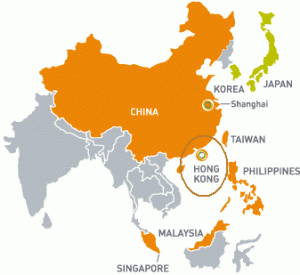Bank Regulations in Hong Kong

Hong Kong’s Financial Center
Hong Kong is a major international financial center, comprising an integrated network of institutions and markets which provide a wide range of products and services to local and international customers and investors. Hong Kong’s financial markets are characterized by a high degree of liquidity and operate under effective and transparent regulations, which meet international standards.
Who Regulates the Banks?
The Hong Kong Monetary Authority (HKMA) regulates the banking industry in Hong Kong. The HKMA was established in 1993 (HKMA logo on the right), by merging the Office of the Exchange Fund with the Office of the Commissioner of Banking. This was done primarily to ensure that the central banking functions of maintaining monetary and banking stability can be performed with a high degree of professionalism and continuity, in a manner that commands the confidence of the people of Hong Kong and the international financial community.
The HKMA was established in 1993 (HKMA logo on the right), by merging the Office of the Exchange Fund with the Office of the Commissioner of Banking. This was done primarily to ensure that the central banking functions of maintaining monetary and banking stability can be performed with a high degree of professionalism and continuity, in a manner that commands the confidence of the people of Hong Kong and the international financial community.
The HKMA is headquartered in the International Finance Centre. Joseph Yam had been the chief executive since the founding of HKMA in April 1993, until 1 October 2009 when he was succeeded by Norman Chan, for a term of five years.
The HKMA is the government authority in Hong Kong responsible for maintaining monetary and banking stability. Its main functions include:
- maintaining currency stability within the framework of the Linked Exchange Rate system
- promoting the stability and integrity of the financial system, including the banking system
- helping to maintain Hong Kong’s status as an international financial center, including the maintenance and development of Hong Kong’s financial infrastructure
- managing the Exchange Fund
Regulatory Regime
The regulatory regime in Hong Kong is principles-based vs. rules based. The essence of a principles-based regulatory system is that general principles take precedence over specific rules. This kind of regulatory regime sets forth desired outcomes but them permits the regulated financial services companies to exercise their own judgments about how to best achieve those results.
On-Site Examination
The HKMA periodically conducts on-site examinations of individual institutions. The coverage of an examination may range from an investigation of specific areas to a comprehensive review of an institution’s operations. Thematic examinations of selected institutions allow the HKMA to benchmark the institutions’ risk management practices on important business lines and major risk areas. On-site examinations provide a valuable opportunity to assess at first-hand how an institution is managed and controlled.
Off-Site Review and Prudential Meeting
As on-site examinations are periodic in nature, in order to achieve “continuous supervision,” they are supplemented by on-going off-site analyses of the financial condition of individual institutions and the assessment of the quality of their management, including the policies and systems in managing risks.
The scope of off-site reviews ranges from regular analysis of statistical returns, covering various aspects of the operations of authorized institutions, to an extensive annual review of the performance and financial position of individual institutions. Annual off-site reviews are usually followed by a prudential meeting with senior management. Frequent contacts are also made with individual institutions at various levels of management as specific issues arise.
Minimum On-Shore Personnel Requirements for Banks
An Authorized Institution must appoint a chief executive and one alternate chief executive who are resident in Hong Kong in respect of the business in Hong Kong, i.e. they do not need to have such role for the bank or business interest.
Regulatory Reporting Requirement
An Authorized Institution has a duty to report a prospective inability to meet its obligations to the HKMA and provide the HKMA with information of a material nature. It should be noted that under, Hong Kong anti-money-laundering and terrorist financing legislative (including the AMLO) Authorized Institutions are expected to report suspicious transactions to the Joint Financial Intelligence Unit.
Capital Adequacy
The capital adequacy framework for banking supervision in Hong Kong has closely followed the internationally accepted standards published by the Basel Committee on Banking Supervision. Applicable to all locally incorporated authorized institutions, the current framework consists of:
- a minimum capital adequacy ratio that an Authorized Institution should maintain
- a supervisory review process to set and review individual institution’s minimum capital adequacy ratio requirements
- a set of disclosure standards applicable to the institution’s state of affairs, profit and loss and capital adequacy
The current framework makes available a number of approaches for authorized institutions of different levels of sophistication to calculate their capital requirements. The use of some of the approaches requires the prior approval of the Monetary Authority based on certain specified criteria. Authorized institutions are required to report their capital adequacy ratios based on the appropriate approaches every quarter.
Capital Requirements for Banks
The minimum aggregate amount of paid up share capital and the balance of the share premium account required is:
- HK$300 million for a fully licensed bank
- HK$100 million for a restricted license bank
- HK$25 million for a deposit-taking company
Additionally, a fully licensed bank must have total customer deposits of at least HK$3 billion, excluding certain deposits and total net assets of at least HK$4 billion. These amounts may be in HK dollars or an equivalent in any other approved currency. There are no total customer deposit requirements for a restricted license bank or a deposit-taking company. Notwithstanding this, the HKMA must be satisfied that any Authorized Institution applicant has and will continue to have adequate financial resources once it is authorized.
Supervision of Liquidity
The Authorized Institutions are required to comply with the statutory requirements of maintaining a liquidity ratio at 25%. They are also required to develop effective frameworks for liquidity risk management under normal and stressed situations, cash flow management and contingency planning for liquidity crises.
The HKMA monitors the level and trends of authorized institutions’ liquidity positions and their ability to withstand stress liquidity scenarios through reviewing the returns and management reports submitted by them.
Derivatives and Risk Management
The HKMA takes a proactive approach in the supervision of authorized institutions’ derivatives activities, focusing on three areas:
- controls – to ensure that authorized institutions have adequate internal control systems to manage the risks of their derivatives activities
- capital – to ensure that authorized institutions have adequate capital to support possible losses in their derivatives business
- capability – to ensure that there is adequate expertise within the HKMA to develop risk management policies and to supervise authorized institutions’ derivatives activities
Compliance with Basel Core Principles & Supervisory Approach
The HKMA seeks to establish a regulatory framework in line with international standards, in particular those recommended by the Basel Committee on Banking Supervision. The objective is to devise a prudential supervisory system to help preserve the general stability and effective working of the banking system, while at the same time providing sufficient flexibility for authorized institutions to take commercial decisions.
The HKMA adopts a risk-based supervisory approach based on a policy of “continuous supervision”, through on-site examinations, off-site reviews, prudential meetings, co-operation with external auditors and sharing information with other supervisors. This aims at detecting any problems at an early stage. The “CAMEL” rating system helps identify institutions whose weaknesses in financial condition, compliance with laws and regulations, and overall operating soundness require special supervisory attention.
Anti-Money Laundering Rules: Hong Kong vs. USA
An article published on August 25, 2014 by the South China Morning Post provides insights into the differences of how anti-money-laundering is handled in Hong Kong vs. USA.
According to the post, “Standard Chartered is the latest global bank with extensive operations in Hong Kong to learn the hard way that financial regulators in the city and the United States take a very different approach to the enforcement of anti-money laundering efforts.” Last week, the NY Department of Financial Services fined Standard Chartered US$300 million as a result of its NY branch failing to flag high-risk transactions from clients in HK and the UAE. The HKMA has never fined banks for similar breaches, although penalties were imposed on individuals. As an example, Luo Juncheng was imprisoned for 10.5 years last year for money laundering (HK$13 billion)
The KHMA insists that the standards in HK are just as high as in the USA, although supervisory tools may differ. Both HK and USA are members of the Financial Action Task Force (FATF), requiring banks under their watch to have measures in place to report or monitor their customers to prevent the bank networks being used for illegal transfers.
“Hong Kong, as a major commercial and trading hub in Asia, naturally has a very large volume of cross-border transactions,” the spokeswoman from HKMA said. “Using different supervisory tools doesn’t mean we have a weaker regime. We have a wide range of powers under the banking ordinance which allow us to ensure continuing enhancement on banks’ anti-money-laundering and counter-terrorism controls. “HKMA is empowered to restrict banks’ business and remove their management teams in extreme scenarios.” Graham Lim, a partner at law firm Jones Day, said regulators in the US – in contrast to their Hong Kong counterparts – had decades of experience tracking suspect transactions.
Sources:
http://www.gov.hk/en/about/abouthk/factsheets/docs/financial_services.pdf

KSENIYA (KATE) STRACHNYI is an advisory consultant focused on risk management, governance, and regulatory response solutions for financial services institutions. Areas of expertise include governance frameworks, enterprise risk management programs, ICAAP, compliance risk management, operational risk management, Foreign Enhanced Prudential Standards, Basel II/III, and the Dodd-Frank Act.








